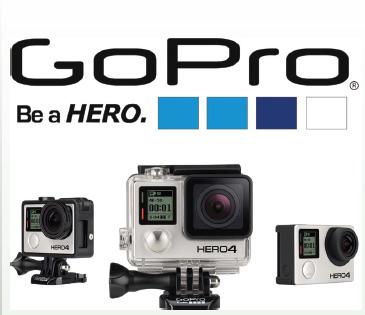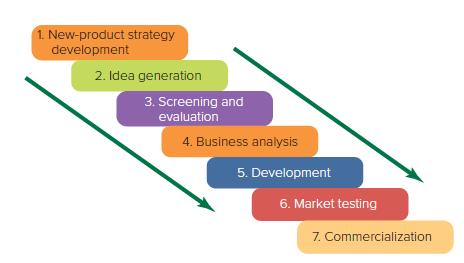hockey players, parents, sky divers, scuba divers, pilots, and just about anyone with a passion for life.
Question:
hockey players, parents, sky divers, scuba divers, pilots, and just about anyone with a passion for life. In fact, GoPro estimates that more than 1 billion minutes of GoPro video are viewed each year, just on YouTube!
Woodman and his friends call it “the GoPro movement.”
“Joining the GoPro movement is all about joining the GoPro community around the world,” says Wilkenfeld.
“This is a group of passionate people that live a big life and love to experience things.” GoPro’s success at attracting customers from around the world is supported by its commitment to developing new products that meet their needs. According to Wilkenfeld, “One of the biggest challenges of developing technology is getting ahead of the consumer and developing things that you think they are going to need.”

THE COMPANY:
GoPro’s history of new-product development is truly inspirational, particularly when the current product line is compared to the first offering. As Kelly Baker, director of media relations, explains, “The first product out on the market was in this big, kind of clunky, plastic housing attached to your wrist that you could flip up and down. It captured images on 35mm film that you would take into a pharmacy or photography studio and get your pictures printed.” That product was replaced by the Digital HERO camera which was powered by one AAA battery and provided silent 10-second VGA videos.
Other new products soon followed. GoPro added audio capabilities, wide-angle lenses, and time lapse features.
In addition, mountable versions that included Helmet HERO, Motorsports HERO, and Surf HERO expanded its market beyond the wrist-camera positioning.
The biggest shift in popularity, however, occurred when GoPro added the HD HERO featuring 1080p images.
Complementary products such as removable battery packs, video editing tools, a GoPro app, and Wi-Fi remote controls were also added to the product line.
As the popularity of GoPro products grew so did the company, leading to its IPO on the Nasdaq stock exchange.
According to Baker, “the most impressive statistics are the growth in employees and the growth in sales.” Today the company has more than 1,300 employees and $1.5 billion in sales.
THE PRODUCT DEVELOPMENT PROCESS AT GOPRO:
The stream of new products is essential to GoPro.
“What’s special for GoPro is that we’re a company built on passion and, ultimately, on the shoulders of our consumers,”
remarks Wilkenfeld. Generally, the company follows a rigorous sequence of steps or stages to maintain its offerings for consumers.
The first stage, new-product strategy development, reflects GoPro’s environmental scanning efforts.
Initially Woodman and his friends observed the social trend toward sharing experiences. This trend was facilitated through its cameras and the growth of social media.
GoPro also recognized a growing interest in capturing unique situations and camera angles where the use of other cameras such as smartphones isn’t feasible.
To build on this trend the company announced a developer program that allows third-party companies to build GoPro compatibility into their products. BMW, for example, created an application that combines GoPro video with telemetry data and location data to add value for its customers, while Fisher-Price is planning to build GoPro mounts into its Jumperoo and Walker products to provide a child’s perspective.
The second stage is idea generation, which is the result of several distinct activities at GoPro. “When we’re developing new products there are two different sources—one being just a crazy idea that an engineer or Nick or somebody on the team has, and then there is a more formulaic approach,” says Wilkenfeld. Both approaches work well at GoPro, where employees are so passionate about GoPro they are constantly thinking of new ideas and where an open innovation perspective encourages ideas from consumers, retailers, and a team of amateur and professional athletes. GoPro even offers awards for the best content submitted to its website—in a variety of categories such as action, adventure, music, animals, family, travel, and science—where new and creative ideas are often found.
Screening and evaluation involves an assessment of each idea to determine if it warrants further effort.
Although this stage assesses a variety of quantitative requirements of new technologies, GoPro is also careful to assess qualitative aspects of new ideas. “If you are all about the data and you’re completely data-driven, then you’re only going to be doing things that the consumer is asking you to do, and you’re not exploring and experimenting and really coming up with ideas that the customer didn’t necessarily know that they needed or wanted,” Wilkenfeld explains.
Once an idea is approved, GoPro begins its business analysis step, which involves building a “business case”
for the idea. One of the key considerations in this step is the potential for cannibalization. For example, when GoPro introduced its HERO Session camera at a price much lower than other GoPro models it had to consider the possibility of cannibalizing sales of its own products.
The amount of time needed to reach break-even points and the likely timing for competitors to respond to new products must also be considered. “Life cycles are definitely a consideration,” says Wilkenfeld.
GoPro begins to turn the idea into a prototype in the development stage. The team often produces a prototype with 3D printers to check the aesthetics and the dimensions of new products. Once the final design is determined, functional prototypes are developed. Wilkenfeld explains, “Our product teams test early prototypes to see if the functionality is there, if it’s a viable product to take to market, before we get too far down the path.”
Once production-quality prototypes are available, GoPro begins stage six, market testing. The first element of the testing engages GoPro’s employees. According to Wilkenfeld, “We have a program every Thursday called Live It, Eat It, Love It, which is about living the brand.”
Employees go out and test GoPro products to provide feedback to the product development teams. A second element of the testing process sends prototypes to social media advocates, professional photographers, athletes, and past consumers to identify final changes to the products.
Changes from market testing lead to the final stage of the new-product development process, commercialization.
At this point a good marketing plan is important.
According to Wilkenfeld, “To be successful at the launch of a new product you’ve got to be very cognizant of what the right levers are to pull and what the audiences are, with digital marketing specifically.” Stephanie Miller, senior manager of the GoPro Social Team, agrees:
“Social media play a huge role in the go-to-market strategies for product releases and product launches. First and foremost, it starts with using social as a listening tool to understand the macro climate and key business trends that we are going to be launching the product into.”
Providing its customers with a steady stream of new products means that the new-product development process is an ongoing activity at GoPro. The process varies for different types of products, though. “The typical product development life cycle is really going to depend on the type of product,” explains Wilkenfeld. “You have products that could take a few months turnaround time, and then you have products that could take a couple of years, it really just depends on the complexity of the product.” Although GoPro’s success has certainly been related to the products it develops, there is also another element to its success. Wilkenfeld smiles and explains that to be successful “you also have to market the products!”............
Questions
1 What are the points of difference, or unique attributes, for GoPro products?
2 What are GoPro’s primary target markets? How does content marketing influence these markets?
3 Describe the new-product development process used at GoPro. What are the similarities and differences to the process described in Figure 10–3?
Fig 10-3

4 Which of the eight reasons for new-product failure did GoPro avoid ensuring the success of its products?
5 Identify one new-product idea you would suggest that GoPro evaluate.
Step by Step Answer:






